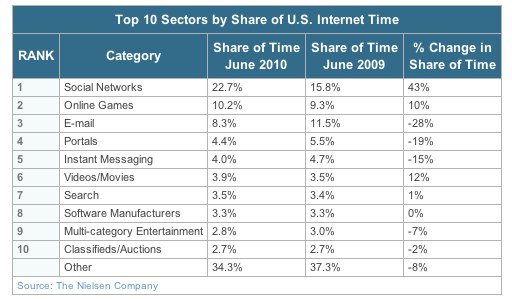Nielsen: Americans spend more time on social networks, less time with e-mail

Americans are changing the Internet usage habits and, increasingly, they're spending a bulk of their time on social networks such as Facebook.
It's not a new trend - but the numbers are getting bigger, according to a report released by Nielsen Online. Social networks led the pack last year with 15.8 percent of our online time spent there. But that figure has grown 43 percent in a year, now up to 22.7 percent of our time. Meanwhile, two other categories - video/movies and online games - both saw double-digit gains in usage time, 12 percent and 10 percent, respectively.
So what did we dump? Well, e-mail and instant messaging took the biggest hits, down 28 percent and 15 percent, respectively. We also scaled down our time on portals, down 19 percent.
But here's something to think about - and mind you, some of this stems from watching my teen and pre-teen kids and their friends interact and communicate: These kids are increasingly using the social network as their platform for sending e-mails and chatting over instant message, in addition to the time they spend text-chatting over their mobile phones.
Speaking of mobile, the Nielsen report notes that the Web usage habits change in the mobile landscape. From the report:
The way U.S. consumers spend their Internet time on their mobile phones paints a slightly different picture to that of Internet use from computers. In a Nielsen survey of mobile web users, there is a double-digit (28 percent) rise in the prevalence of social networking behavior, but the dominance of email activity on mobile devices continue with an increase from 37.4 percent to 41.6 percent of U.S. mobile Internet time.
Likewise, music and video/movies on mobile also saw increases of more than 20 percent in share of activity, compared to a year ago. Again, there are only so many hours in a day so, when one category gains, another must lose. On the mobile side, news/current events and sports destinations saw drops of more than 20 percent in share of time.
On the other hand, when you consider that users now have Internet access on their mobile devices, it can create a shift in habits that would explain the shifts that Nielsen is seeing. For example, it seems that if a user can spend time hammering away at e-mail on a mobile device while waiting in line at the bank or during the subway ride home, they don't need to bother with that from their home PCs and can instead spend time interacting on Facebook or otherwise use the home PC as an entertainment device.
